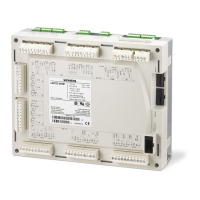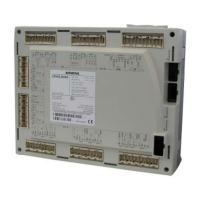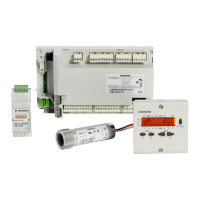
Do you have a question about the Siemens LMV51.100C1 and is the answer not in the manual?
| Brand | Siemens |
|---|---|
| Model | LMV51.100C1 |
| Category | Control Unit |
| Language | English |
General warnings and safety precautions for LMV5 unit.
Guidelines for proper installation and mounting of LMV5 unit.
Notes on electrical wiring, grounding, and installation compliance.
Best practices for disturbance-free signal transmission for probes.
Safety checks to perform during commissioning and maintenance.
Guidelines for adjusting fuel-air ratio control and parameter settings.
Details the basic characteristics of burner control inputs and outputs.
Lists available connection facilities for flame detection.
Explains the self-test function for flame detectors.
Describes separate flame supervision for LMV50/LMV52.
Using an external, approved flame safeguard for supervision.
Supervision of combustion chamber wall temperature for high-temp plants.
Overview of digital inputs used for burner control.
Safety loop input for integrating safety loop and switching fuel valves.
Functions for manually locking the system and resetting from lockout.
Input for fuel selection between oil and gas, or INT.
Input for fan contactor contact or flue gas recirculation pressure switch.
Input for external boiler controller signal as a heat request.
Inputs for external controllers with contact outputs for multistage operation.
Input for an air pressure switch, with activation/deactivation options.
Input for gas pressure switch-valve proving or CPI.
Input for connecting the gas pressure switch-min.
Input for start signal or CPI input for gas/oil valves.
Input for connecting the gas pressure switch-max.
Input for connecting an oil pressure switch-min.
Input for connecting an oil pressure switch-max.
Input for connecting a start signal for oil firing.
Input for connecting a heavy oil direct start signal.
Overview of digital outputs for burner control.
Details the burner control sequence and phase progression.
Setting reaction time for flame loss and safety time during operation.
Function to ensure gas valves are not opened and ignition is off if a leak is detected.
Describes lockout and safety phases, including manual reset and fan states.
Selecting fuel type via AZL5 menu or BACS.
Defines addresses assigned to dampers and actuators for FARC.
Procedures for activating/deactivating actuators based on fuel and application.
Setting the direction of rotation for actuators (standard/reversed).
Describes how program phases advance in tune with the fuel-air ratio control system.
Defines safety time for fuel-air ratio control and dynamic checks.
Explains configurations for using internal, external, or BACS load controllers.
Defines burner operation mode: manual, automatic, or off.
Load controller operates in modulating or multistage modes.
Manually setting PID parameters (P, I, D) or using adaption function.
Identifies controlled system and calculates PID parameters.
Safety-related function that prevents exceeding temperature limits.
Details the terminals and interfaces (CAN, COM1, COM2) of the AZL5 unit.
Describes the 3 ports: LMV5 CAN, PC RS-232, and BACS e-bus interface.
Overview of the AZL5 menu structure for displays and settings.
Explains lockout and error messages displayed on AZL5.
Process for selecting and changing standard parameters, requiring password.
Procedure for addressing actuators and assigning functions using AZL5.
Parameterizing fuel-air ratio control curves via menu.
Steps for activating the load controller's PID adaption (self-setting) function.
Performing TÜV test functions like loss-of-flame and safety limit thermostat.
Steps for basic system configuration, including burner ID and fuel trains.
Configuring gas valve proving parameters.
Procedure for addressing actuators and assigning functions via AZL5.
Activating/deactivating actuators for LMV50/LMV51, defining air-regulating actuators.
Configuring the load controller's operating mode and sensor input.
Selecting and configuring the appropriate sensor for the load controller.
Setting fuel-air ratio control system for gas-fired burners.
Checking and adapting actuator positions for gas ignition.
Adjusting burner output curves manually, defining points.
Setting up multistage oil-fired operation, including mode and curve parameters.
Checking and adapting ignition positions for oil firing.
Performing valve leak tests to determine leakage rate.
Configuring the load controller's operating mode and sensors.
Selecting and configuring the appropriate sensor for the load controller.
Defining control parameters for the load controller in 3 ways.
Acquiring system data to calculate PID parameters via adaption.
Integrated temperature limiter observes a separate temperature limit.
Protects boiler from thermal shock during cold starts.
General guidelines for mounting and installation of the unit.
Rules for wiring, separation of low-voltage sections, and cable types.
Details on powering the LMV5 via external transformer AGG5.2.
Details on VSD module function, control, and parameter settings.
Configuring VSD according to connected motor type and ramps.
Automatic measurement function for standardizing VSD speed.
How O2 trim control reduces combustion air based on control deviation.
Operating modes for O2 trim controller and O2 alarm.
Deactivating or activating O2 trim control/alarm via parameter settings.
Special start modes for burners with metal mesh heads in O2 control.
Using O2 alarm with or without O2 trim control.
PLL52 module for residual oxygen control, connected via CAN bus.
Instructions for commissioning the O2 trim control system.
Adjusting ratio control curves with sufficient excess O2 under various conditions.
Adjusting O2 alarm settings, initially deactivated for safety.
Setting O2 trim control, ensuring O2 alarm is active and parameters are correct.
Viewing and changing adapted PID parameters and time constants.
Setting excess O2 and ensuring correct combustion values.
How FGR reduces NOx by feeding flue gas back to combustion chamber.
Defines operating modes for FGR function and actuator behavior.
Setting fuel-air ratio control with FGR, disabling FGR for initial setup.












